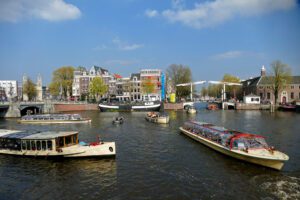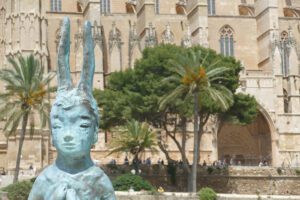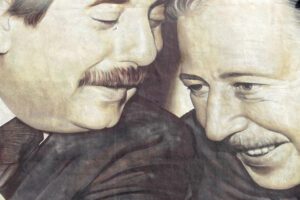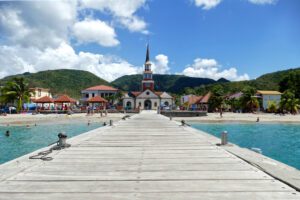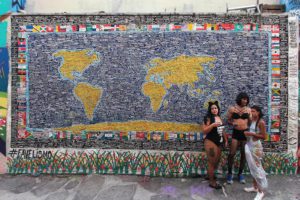After having searched for street art in many different places around the world, after having spent long hours of thorough research about the enigmatic artists, taken tons of pictures of amazing murals, and pinpointed them on maps for you to find, I must say, that putting together a post about the best street art in Guadeloupe was one of the most difficult tasks in this field. The amount of murals on the island is just overwhelming: You’ll find amazing pieces not only on façades in the capital Pointe-à-Pitre. No, walls alongside country roads and even houses in tiny hamlets are decorated with outstanding art.

You might think I’m exaggerating when I call Guadeloupe a gigantic outdoor gallery, but I’m sure that after you’ve read this post, you’ll agree.
Pointe-à-Pitre
Although Columbus discovered Guadeloupe in 1493, the city of Pointe-à-Pitre was founded only in 1763. Today, it is Guadeloupe’s largest city and basically connects the parts of Grande Terre and Basse Terre.
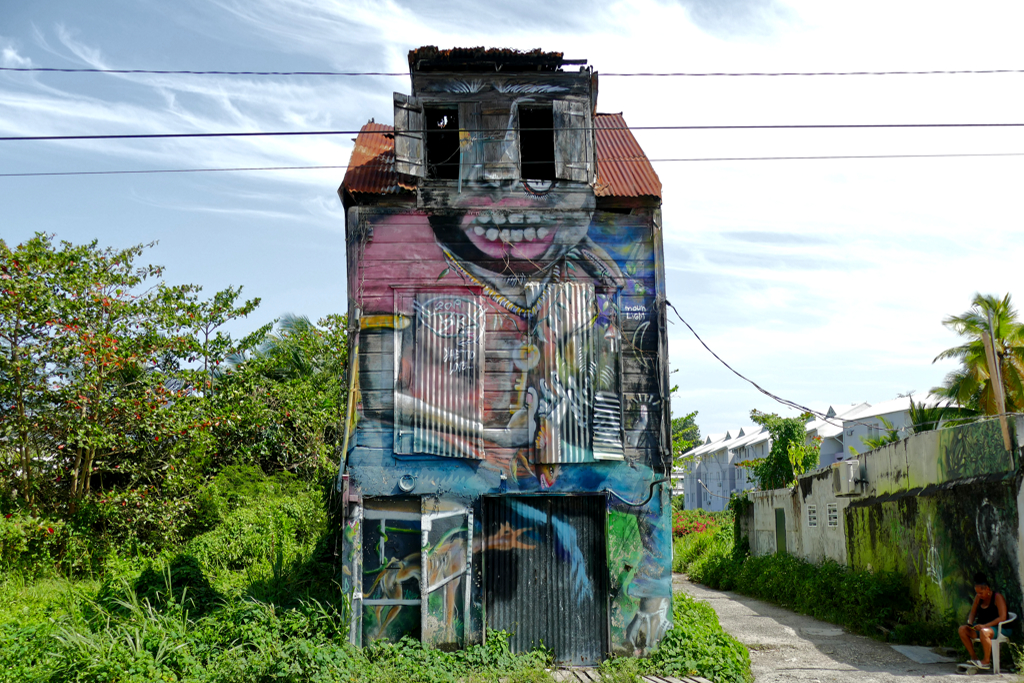
A major fire devastated the place in 1780. After its reconstruction, the municipality grew to around 20,000 inhabitants in only sixty years. At this point, the sugar industry was the town’s main source of income. Sugar was processed in over fifty factories that existed in and around Pointe-à-Pitre. It was then exported primarily to France. After the former main municipality Basse Terre, located in the southwest of the eponymous island, was affected by various destructive cyclones and lived under constant threat of the eruption of the Soufrière volcano, it lost its status to Pointe-à-Pitre.
State of Decay
In all modesty, I have traveled the world a bit in my days. That’s how I became a travel blogger, after all. Unfortunately, I have to say that I can hardly think of any other metropolis that looks as run down and desolate as Pointe-à-Pitre. It already starts with the Place de la Victoire. Obviously, the square has played an important role in Pointe-à-Pitre’s history. But today people hardly even cross the square anymore. Virtually all the stately buildings surrounding the large court are in hopeless decay. And not just that. Everywhere in Pointe-à-Pitre, entire streets seem to have fallen into disrepair.
What do those responsible in the brutalist-style town hall do all day?
Ironically, exactly opposite the town hall in question is Pointe-à-Pitre’s biggest eyesore, namely the Centre des Arts et de la Culture.
At the same time, this center for arts and culture is also one of the most captivating hidden gems in the city.
What? How is that possible?
An Outstanding Art Project
At first glance, the enormous building looks a bit like a stronghold. It’s a massive gray construction on an overgrown plot of land. It’s hard to tell if it’s half-built or half-ruined. The chain-link fence around the property is holey and bent down in some places. Even though I could have gotten onto the property quite easily, I initially took pictures only over the fence since I simply didn’t dare enter this spooky and lost place.
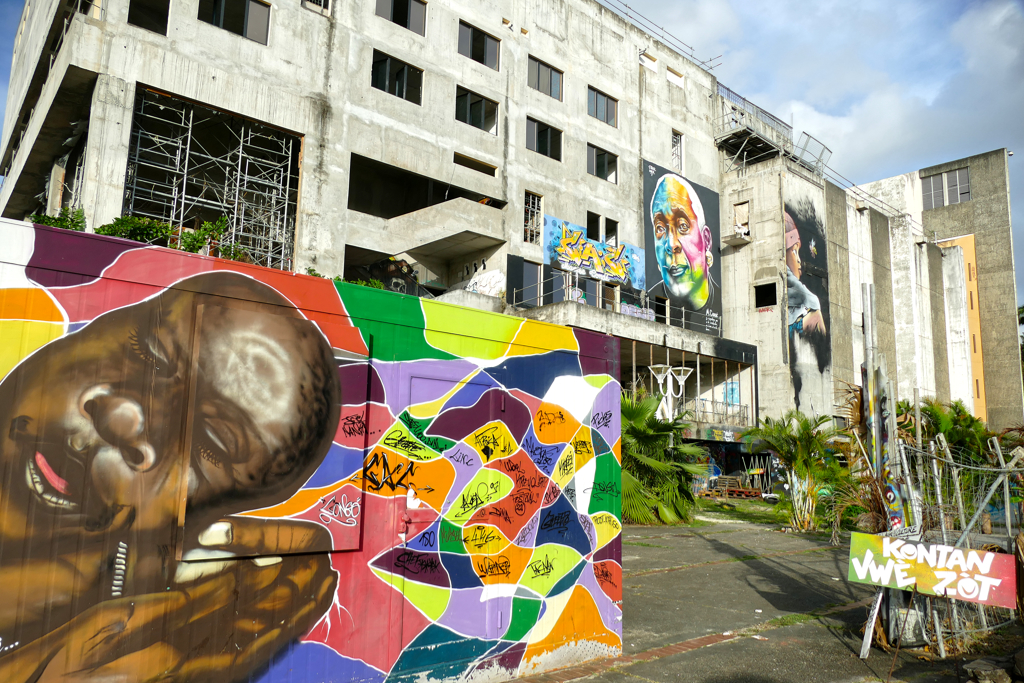
Fortunately, I later came back with a knowledgeable tour guide, but this is something I explain below. However, from him, I learned that despite its appearance, the building is not a shady crack house but an amazing art center that every art buff coming to Pointe-à-Pitre should absolutely visit.
How It All Began
As a matter of fact, the galleries were opened as an art and culture center way back in 1978. For the longest time, it was a popular venue promoting Guadeloupean and international artists.
But as things go, it supposedly has been under renovation for many years.
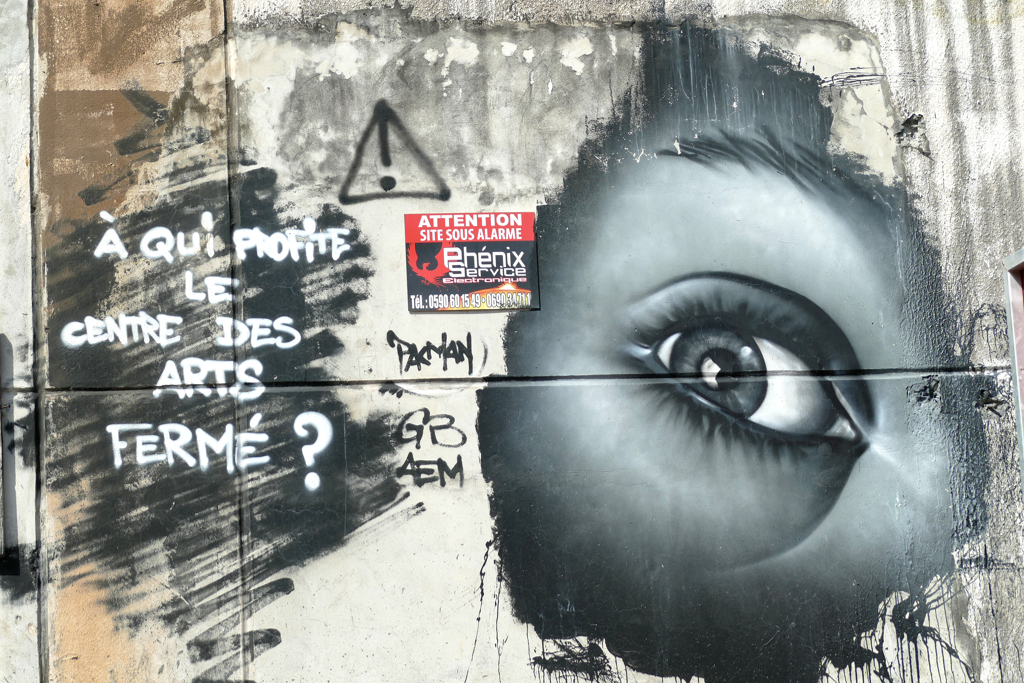
In fact for so many years, that some artists grew tired of waiting. Therefore, in 2021, the Kolèktif Awtis Rézistans, hence, the artist collective in resistance, occupied the building in a non-violent coup.

This collective consists of around a hundred artists such as painters, sculptors, musicians, actors, and poets. While they are understandably frustrated by the authorities’ oblivion and neglect of the arts, they still make the best of this state of insecurity.
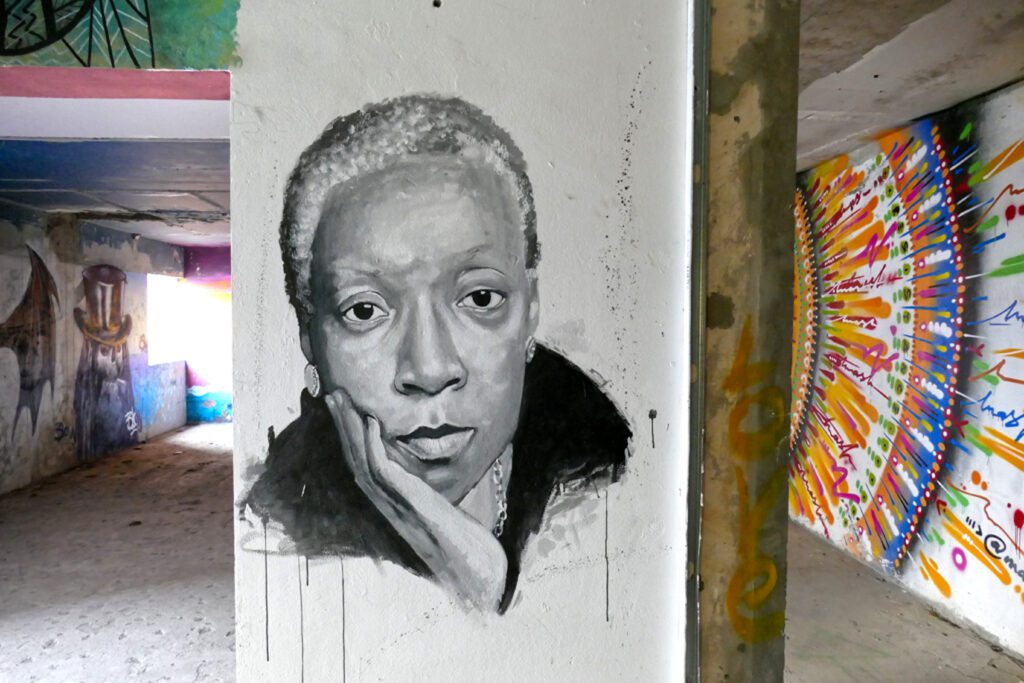
The most striking part of the center is of course the colorful and expressive murals painted both, on the outside wall and in the interior rooms. In fact, almost all of the artists that I’m introducing in this post have left their colorful traces on the crumbling walls of the Centre des Arts et de la Culture.
An Urban Odyssee
The association Atelier Odyssée has been trying for years to restore parts of the historic center of Pointe-à-Pitre. Volunteers and residents repaint the façades, decorate walls with murals, or create community gardens. The goal is to change the image of the district and to improve the neighborhoods for their residents.
Sadly, drugs and prostitution have dominated the old town for the past years. This of course leads to uncertainty and fear among the residents. Sylvie Adélaïde is an urban planner, architect, and visual artist. As president of the association, her goal is to preserve Pointe-à-Pitre’s old buildings and make the city more livable.

When looking for solutions, the idea was first to enhance the appearance of the district. It has been proven that an external improvement leads to a change also from the inside in the long term. Hence, the houses were repainted as part of the Pli bel lari campaign.
And indeed, little by little, professionals rented business spaces in the area. With restaurants like 1973 Food & Sound, the harbor district slowly developed into an insider tip.
A fine example of gentrification that came from within the community.
Where decline has left gaps between the old structures from the 19th century, Atelier Odyssée volunteers have planted urban gardens.
Finally, the association also organized a street art workshop with the support of Al Pacman. Pacman created an almost irritatingly large part of the murals at Pointe-à-Pitre. He is also essentially the artistic director of the Kréyol Art Festival, which has taken place annually since 2018 – except in the Covid year of 2020.
It looks like the color holds the crumbling walls together, and you wonder to what extent it also consolidated the cultural identity of the residents.
Pousse Pousse – a Different Kind of a City Tour
I got to know the Centre des Arts et de la Culture and some other semi-hidden cultural projects as part of an excursion organized by the tour operator Pousse Pousse – Ti Balad Peyi. The people at Pousse Pousse have made it their mission to bring interested visitors to extraordinary places and show them sides of Pointe-à-Pitre that would otherwise not be easily accessible.
Before our Tuk Tuk finally reached the Centre des Arts et de la Culture, our energetic and enthusiastic guide Loïck had already led our small group of six foreign visitors to the Green Hostel*, the former townhouse of a rich rum magnate. Here, ambitious folks opened the island’s first youth hostel. But that’s not all: It is actually an accommodation committed to environmental friendliness as well as the arts.

We then took a detour to the former workers’ accommodation at the Darboussier sugar plant. Today, this dilapidated residential complex has also been transformed into a cultural center called Asosiasyon Kiltirèl Cinkant Cinkant, hence, the culture association fifty-fifty.
There is another art project in Pointe-à-Pitre, which is in the former old presbytery of Saint-Pierre-et-Saint-Paul on the northwestern corner of the Place de la Victoire. It is now called Pavillon de la Ville and makes up for its pitiful appearance by housing inspiring art exhibitions. It wasn’t on the program on our tour, but you can of course visit it by yourself.

In fact, you can visit all of these sites yourself. However, it is far more informative and enjoyable to take a tour with a knowledgeable and passionate guide like Loïck. You can book various vehicles and tours cheaply on the Pousse Pousse – Ti Balad Peyi website**
Best Street Art Outside of Pointe-a-Pitre
The highest concentration of street art can be found in Pointe-à-Pitre, as committed artists have been able to set up admirable projects there against all odds in recent years. But there are also lots of impressive murals outside the city.
Here are some outstanding examples of street art outside of Pointe-à-Pitre. You can then find out more about the artists in the next section.
Le Gosier
Le Gosier is located on the south coast not very far from Pointe-à-Pitre. Tons of public buses pass by or go straight into the town center. After all, it’s the only place in Guadeloupe with a direct connection to the airport by public bus. I guess that tells you a lot: It’s rather busy than laid-back, so you’ll find many water activities apart from sandy beaches. Also, there is a huge marina, and there are tons of shops, restaurants, bars, and even a casino.
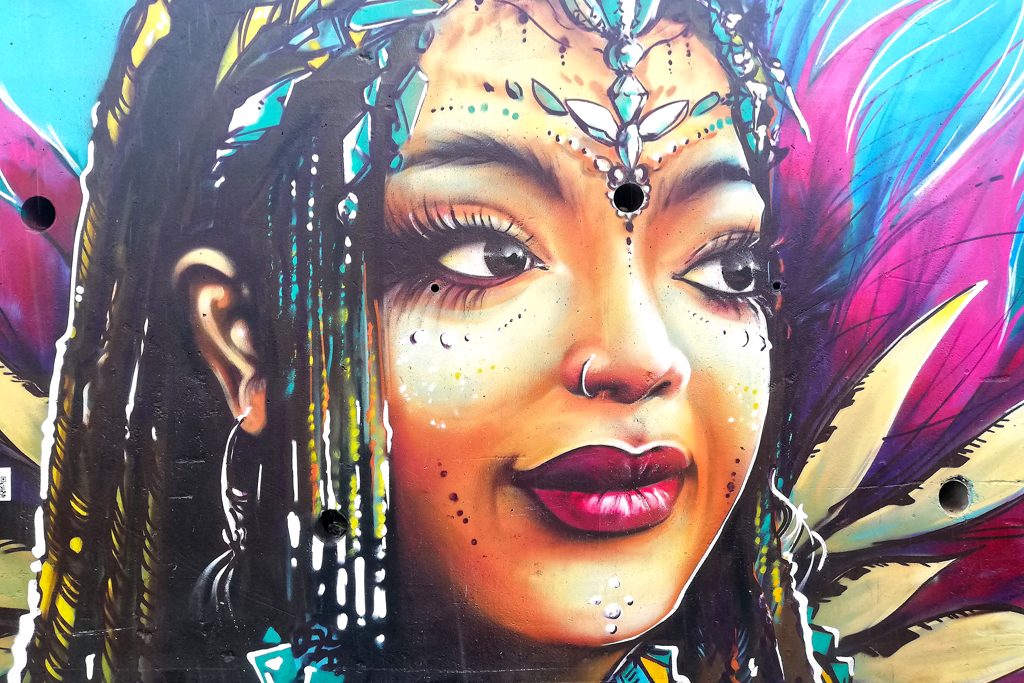
When it comes to urban art, don’t miss out on Jimmy Sheik‘s portraits on the wall surrounding the graveyard. In the section below in which I introduce the artist, you will find two more portraits from this series of his murals in Le Gosier.
Sainte Anne
Although Sainte Anne is undoubtedly a very touristy place, too, tourism here is less overwhelming. Despite masses of visitors, the town has managed to retain its authenticity, especially in the backstreets behind the main boulevard.
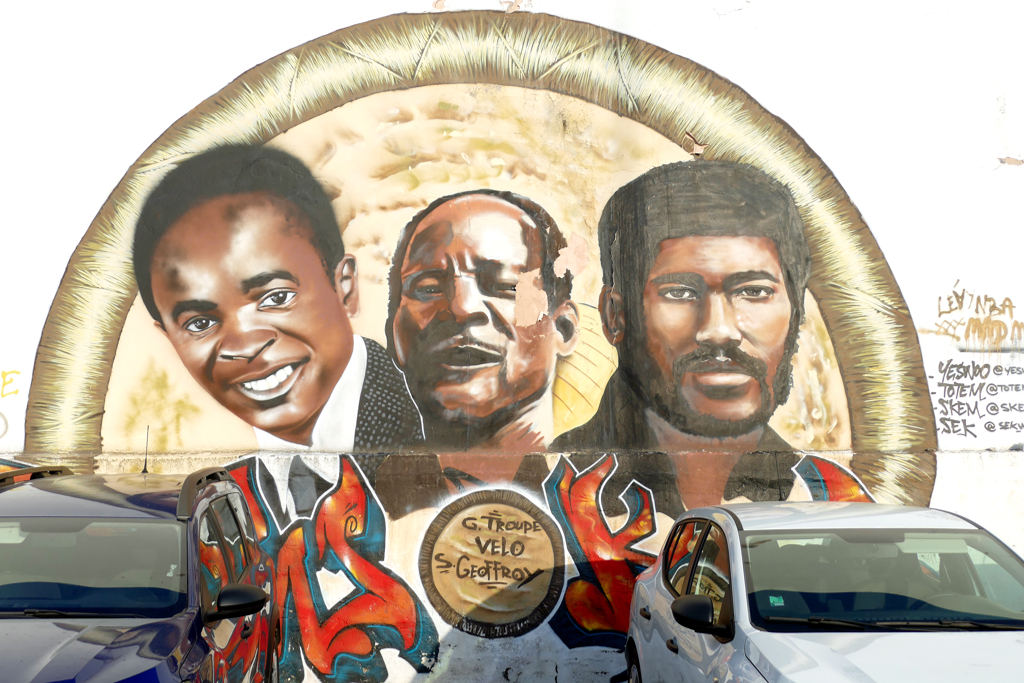
There is an everyday life that tourists can take part in instead of tourist facilities dominating the lives of the locals.

There are a couple of grand murals that you best discover by just strolling the streets and back-alleys of this quite charming little town.
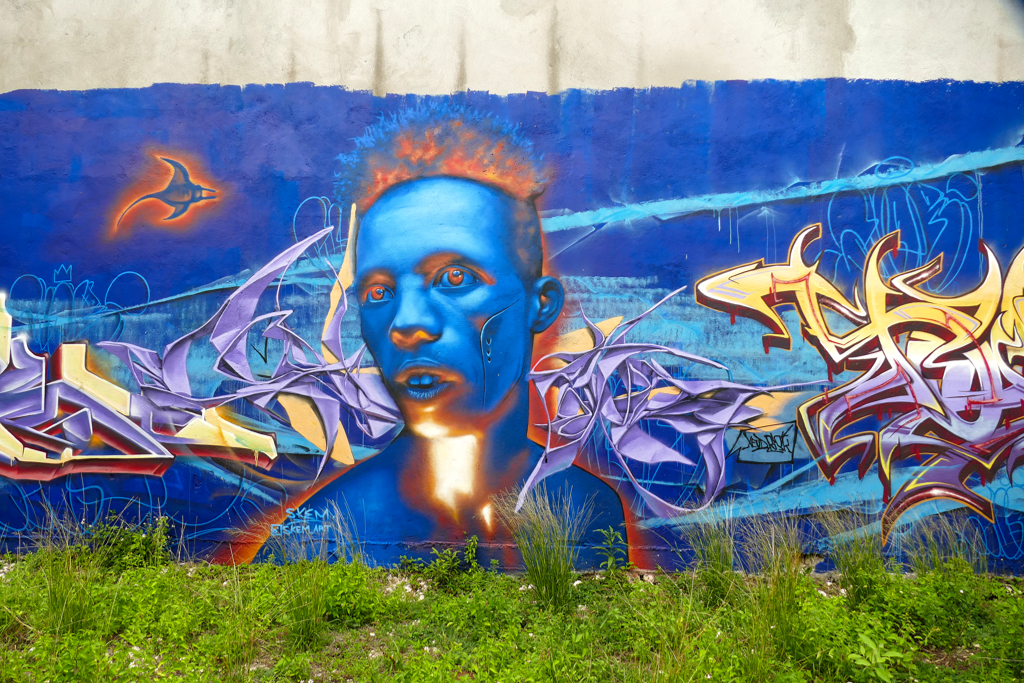
Saint François
Everybody comes to Saint François for the amazing beaches. While the city beaches like Plage de Raisins Clairs are already great, the real beach wonderland begins east of town at Anse du Mancenillier. From there, it gets better little by little. The sand gets finer, the water gets clearer. It’s a tropical dream come true.

Approximately in the middle between Saint François and the Pointe des Châteaux is the Gallery Kreol West Indies right next to the road. They exhibit great works by local artists and sell unique souvenirs. So if you meander in this area anyway, it’s worth a visit. They are open every day from 9 a.m. to 1 p.m. and after a lunch break again from 2 p.m. to 6 p.m.
However, you can admire the murals and sculptures in their front yard at any time, obviously.
Petit Canal
A lot was going on economically in Petit Canal in the past, and the winners and tragic losers in the inhumane trade are undisputed: The small fishing port overlooking the Anse du Canal served as a dock for the ships bringing human cargo from Africa. The so-called Marches des Esclaves, hence, the staircase of the slaves, is the most iconic landmark in the entire region.
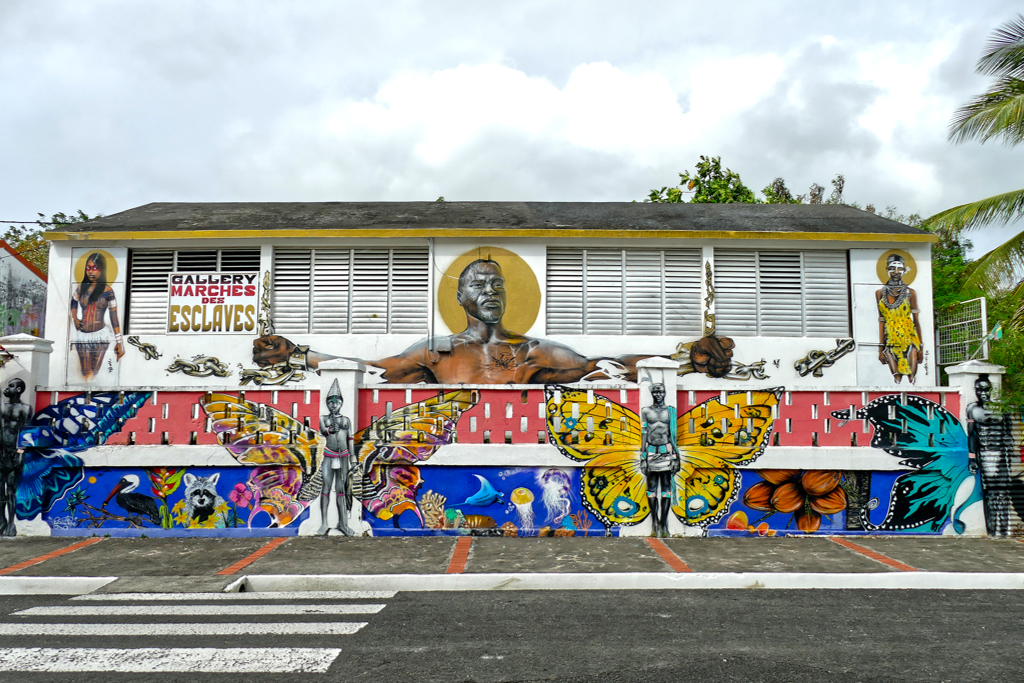
Below the steps is a monument representing the eternal flame of the unknown slave. There is also a bust of Louis Delgrès, the leader of Guadeloupe’s resistance movement against Napoleon’s reintroduction of slavery in 1802.
Right across from stairs and the Église Saint Philippe et Saint Jacques is the Galerie Marches des Esclaves. It boasts some powerful murals all dealing with the topic of slavery.
The gallery is open from Friday to Monday between 8 a.m. and 4 p.m.
Port Louis
At the beginning of the 18th century, the town of Port Louis, named after Louis XIV, was one of the first sugar ports in Guadeloupe. Eventually, it was overtaken first by Le Moule and then by Pointe-à-Pitre.
Today, the small town has a very laid-back vibe and surprisingly powerful urban art.

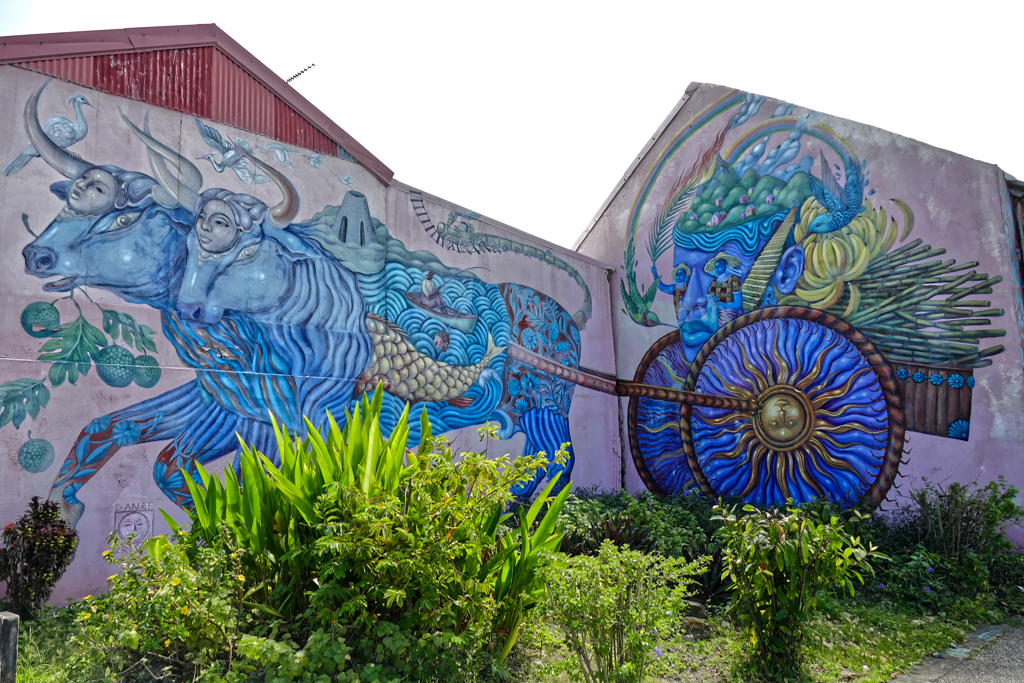
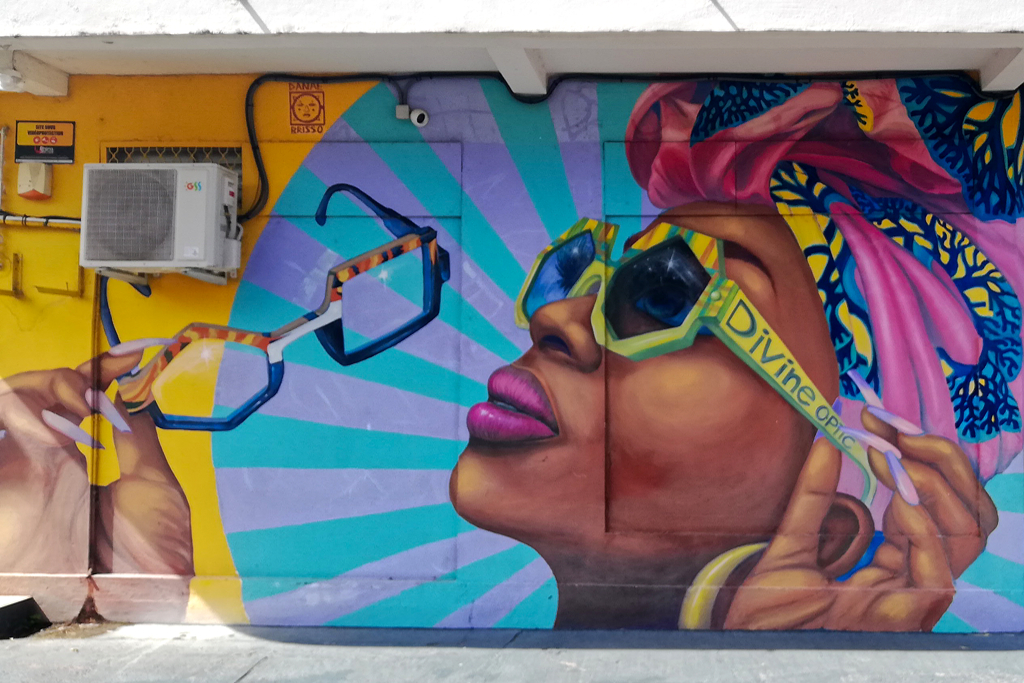
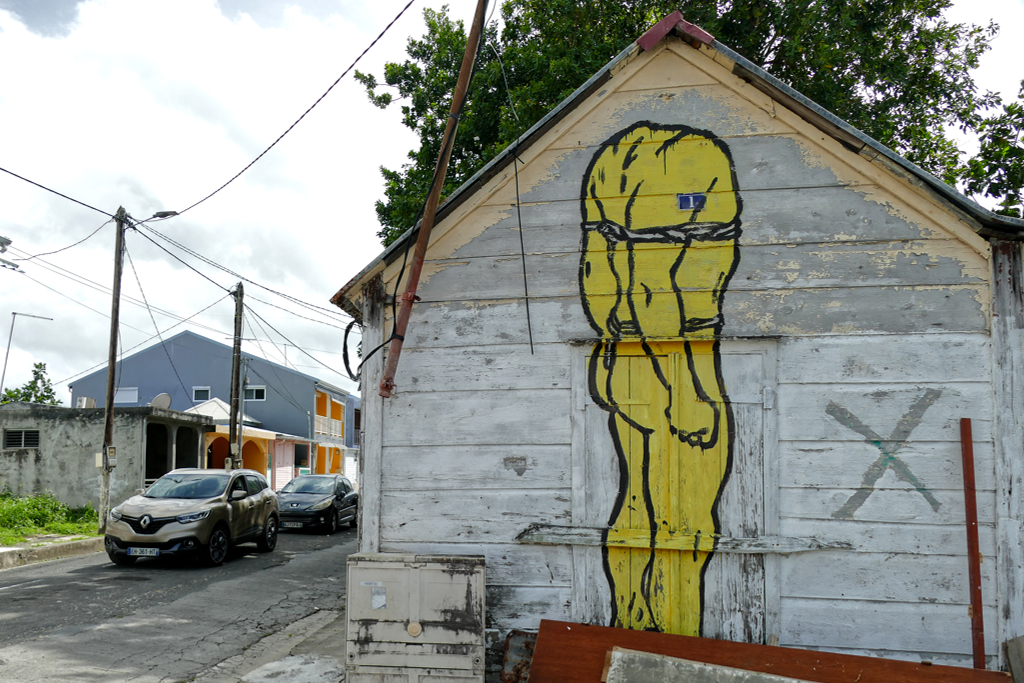
Marie Galante
Apart from the main double-winged island, Guadeloupe actually consists also of four smaller isles that are absolutely worth at least a day trip. The most famous of those gems scattered around the main, butterfly-shaped island is certainly Marie Galante.
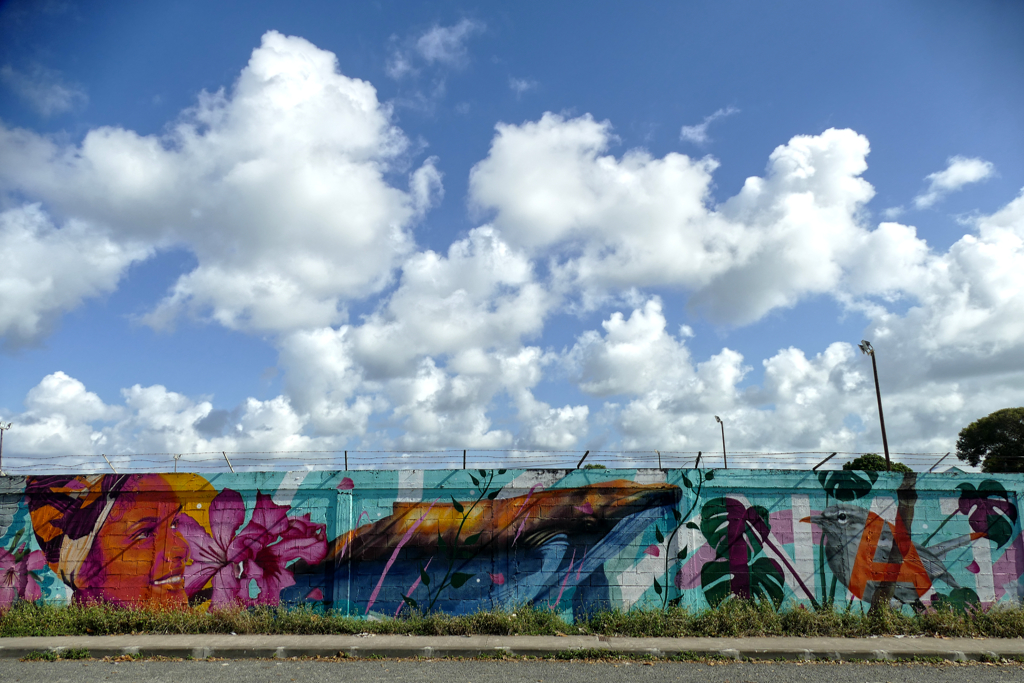
Although there is a lot to see, keep your eyes open while exploring the island, and you’ll certainly spot some amazing murals. Most of them will probably be by Yelow, Marie Galante’s local hero when it comes to urban art.
The Artists
Over the last few years, I have put together many posts about street art in various countries: from painted walls all over Berlin to an abandoned hotel ruin on the island of Naxos. From socio-artistic ventures in Amsterdam, Copenhagen, and Paris to a glamorous and generously funded art project in Morocco’s capital Rabat.
The world seems to be covered with breathtaking murals by renowned artists.
Due to the abundance, street art has lost much of its subversive swag in many places. In London, the former cradle of punk, groups of tourists push their way through the gentrified and therefore tragically hip districts of Camden and Shoreditch.
On the other hand, districts such as the 13th arrondissement in Paris, the Copenhagen Nordvest neighborhood, or the satellite town of San Pablo in the northeast of Seville continue to be visually enhanced through murals in the first step and thereby made more livable in the long term.

And what about Guadeloupe? While there is some street art that is simply for the joy of beautification, many of the murals have at least a hidden message. They remember the colonial past, denounce slavery, deal with political grievances, and at least honor local heroes like the writers Maryse Condé and Sony Rupaire or the physician and scientist Dr. Henry Joseph.
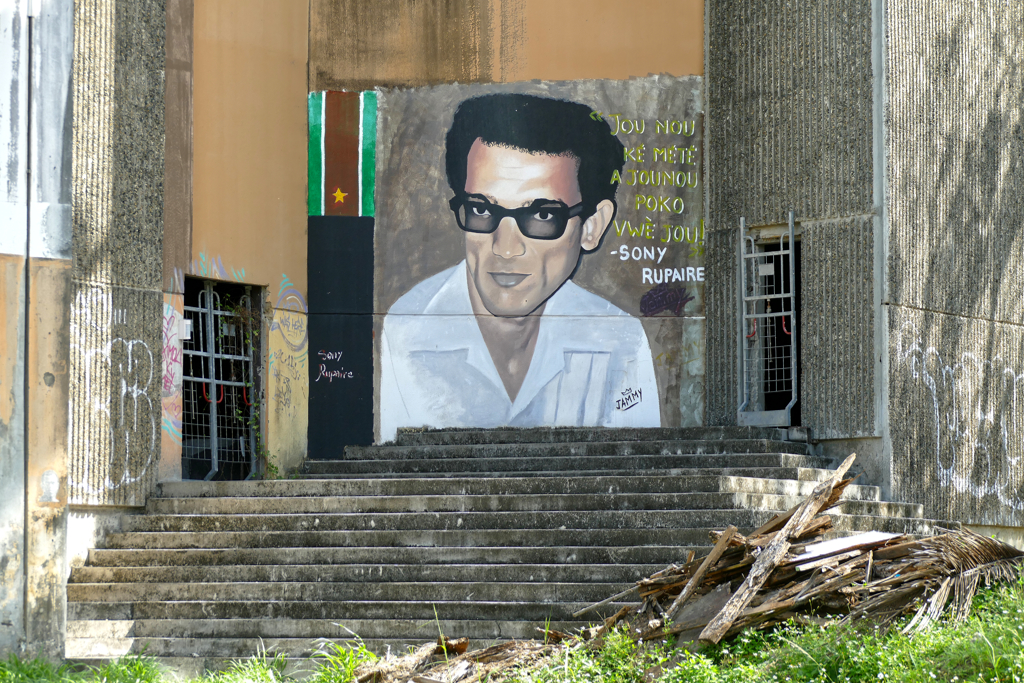
Even if the artistic quality sometimes cannot keep up with the power of the message, the artists listed below have contributed to Guadeloupe’s cultural identity.
ART’SO
Mademoiselle Anne Sophie Bineau, better known under her nom de plume spray can ART’SO, is a self-taught artist. She is a painter and muralist, and she does also tattoos.
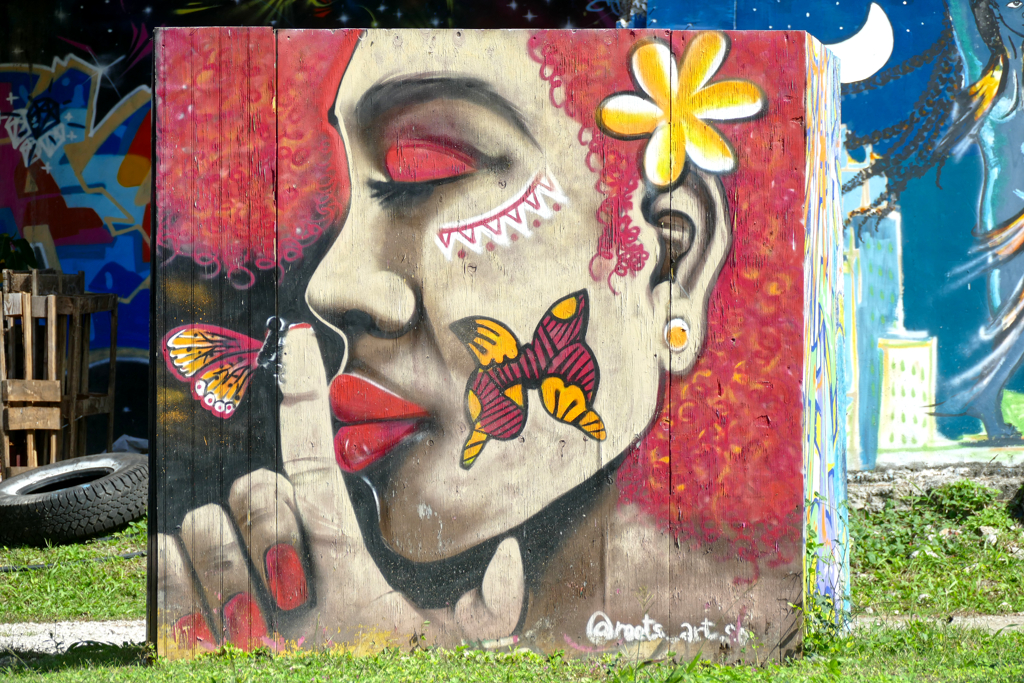
Originally from France, she became a resident of the Caribbean island. After some time in Jamaica, she is currently living in Guadeloupe. Unbelievable but true: Apart from Danaé Brissonnet, she is the only woman on this list – and that’s by no means my fault!
Ronald Cyrille aka B.Bird
Ronald Cyrille aka B.Bird is one of the most prominent members of Guadeloupe’s artistic community. Born in Guadeloupe in 1984, he spent his childhood between Guadeloupe and the neighboring island of Dominica. Since B.Bird experienced life as a Frenchman in Dominica and then as a Dominican in Guadeloupe, he gained an open and comprehensive view of the Caribbean. Through his work, he returns to the different places of his eventful childhood. He immortalizes his homeland’s mythology and folklore in his paintings, which makes him a veritable visual storyteller.
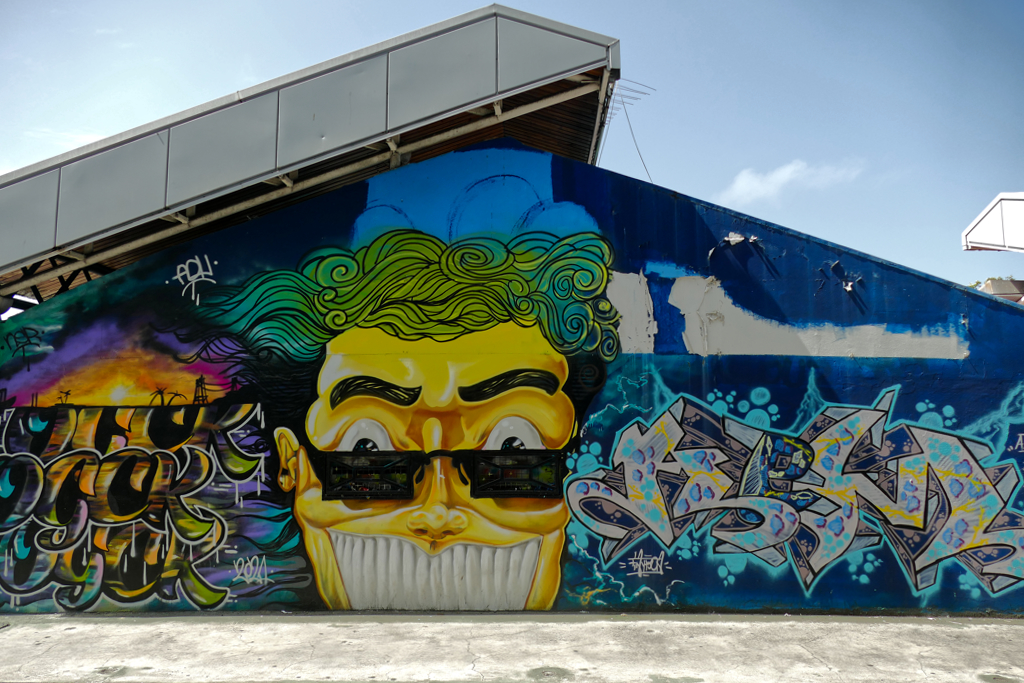
Although today, B.Bird enjoys international recognition with his mythical creatures and mystical scenes, his greatest claim to fame so far was an engagement as an artist in residence at the glorious Memorial ACTe, the museum of the history of slavery in Pointe-à-Pitre.
Bangastyle
Banga was born in Guadeloupe in 1970. He came to Paris at the age of five. In 1982, he learned about hip-hop culture at a show by Afro-American dancers. It was then a short step from being a breakdancer to spraying tags on walls and subways.
He joined various street art crews and learned the basics of graffiti on the street. In 1989, however, Banga taught street art at the University of Paris VIII for two years. Also, he initiated the project BASALT which aims to introduce young people in the most disadvantaged neighborhoods to the art of graffiti.

In the mid-1990s, Banga rented a stall at the famous Clignancourt flea market where he customized clothing and accessories for clients. From flea markets to high fashion: In 1995, he worked with Agnès B on a T-shirt collection for Japan, and two years later, Banga exhibited for the Cartier Foundation for humanitarian causes.
At the invitation of Tats Cru, he painted a middle school in the Bronx, New York.
Finally, Banga founded his streetwear brand and opened two boutiques at the St. Ouen flea market and in Les Halles in Paris.
Danaé Brissonnet
Danaé Brissonnet is a French-Canadian artist from Quebec. Apart from street art, she dedicates herself to mask-making, puppetry, and also illustrating.
To her, working as an artist is far more than just creating something pretty. She invites her audience into a world full of symbolism, myths, and metaphors. Also, she needs to immerse in the culture’n’community of the places where she leaves her mystical traces on façades and walls for instance by organizing workshops. In Guadeloupe, she left behind, among other paintings, a large-format mythological mural in Port Louis.

You can find Brissonnet’s elaborate fantastical and very colorful murals in many European cities, but also in northern and western Africa, the US, Canada, Mexico, and India. I saw her work for the first time during my stay in Morocco’s capital Rabat, and I was immediately intrigued by the imaginative figures that she depicts with impressive attention to detail.
I’ve introduced Danaé Brissonnet in my post JIDAR Street Art Festival – How Rabat Celebrates International Urban Art, and also in my post on Martinique where she painted a fantastic mural in Fort de France.
Yeswoo Dini
Yeswoo Dini’s murals can be seen in many places in Guadeloupe. He is originally from the city of Rennes and came to the island in 2003. Yeswoo Dini became involved in the music and art of hip-hop at a very early age.
In his large-scale works, he celebrates Caribbean women by portraying them in an iconic hyperrealistic style.
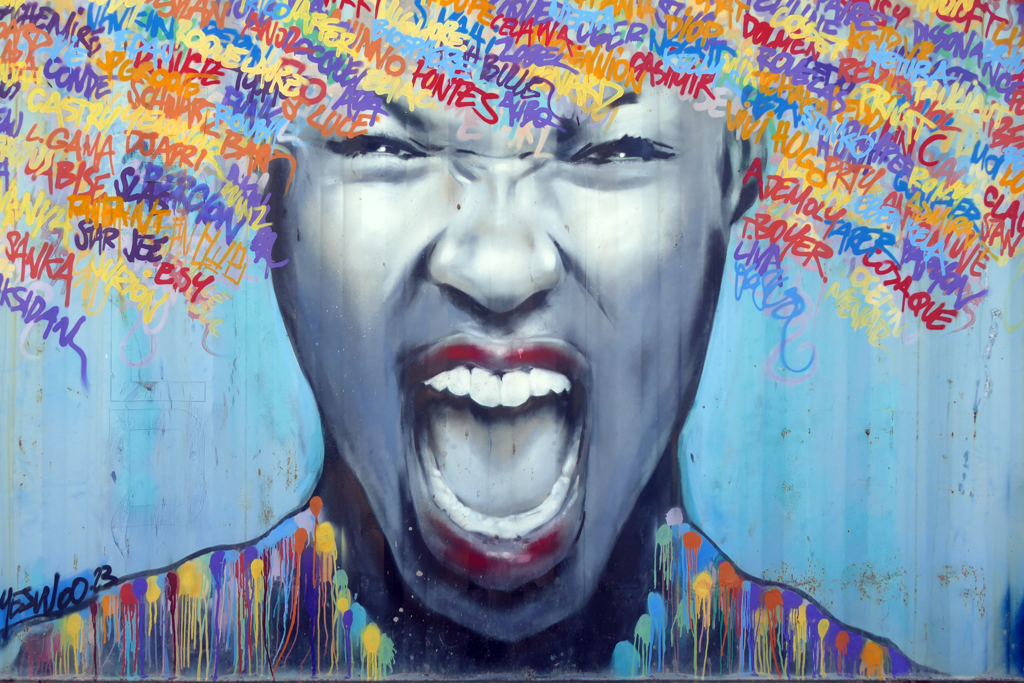
He dedicates a more recent series to the Indian peoples, a topic that Yeswoo is passionate about from both historical and aesthetic aspects. One of his murals is dedicated to Carloman Bassette, a specialist in Indian history from Guadeloupe, who died in 2021.
Hundreds of his works embellish private and public walls in Guadeloupe, continental France, as well as Amsterdam, Brussels, Los Angeles, and New York. He has also taken part in group and solo exhibitions
in Guadeloupe, Martinique, Saint Lucia, and São Paulo.
Youri Arron aka Dougy
Youri Arron aka Dougy was born in Guadeloupe in 1978. He grew up on the island and created graffiti until he was 22. Then he left Guadeloupe to study in the southern French city of Nice, where he ended up staying for almost 20 years. He was dedicated to his work as a sports coach as well as his family. Hence, there wasn’t much time for art. Nevertheless, a street artist at heart, he observed what was going on in this field from afar.
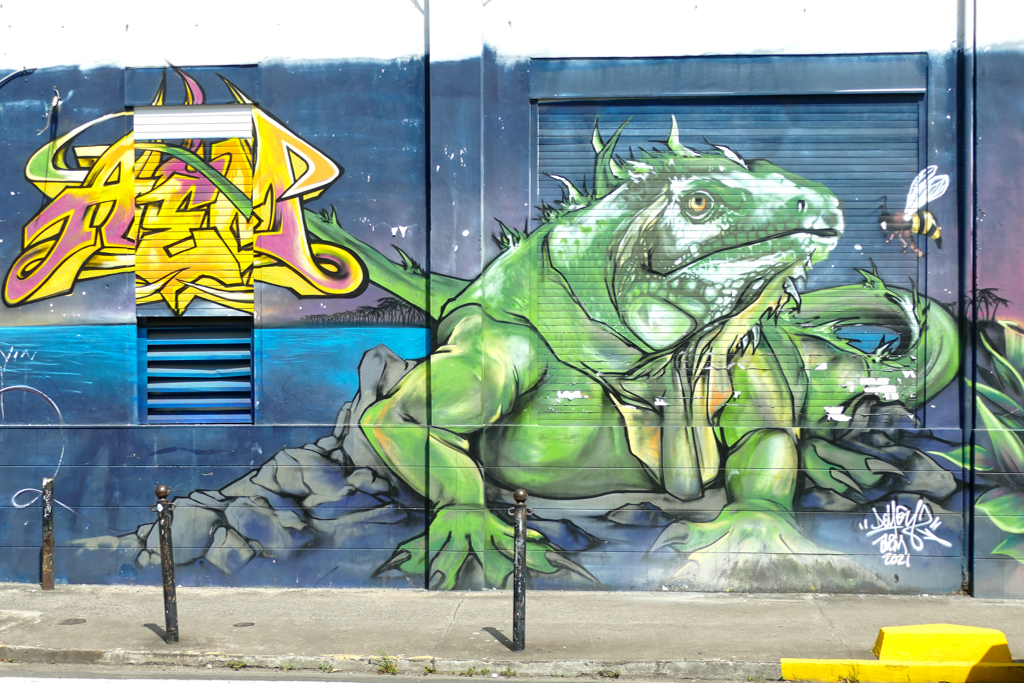
It was only in the last three years, when he returned to his home island during the pandemic, that the urban art scene had him back as an active artist.
GREEFFE
Xavier Sargenton-Charles-Gervais aka GREEFFE has always had a great passion for drawing. At the end of the 90s, he made his art available to the public by painting it on the walls of Pointe à Pitre. However, to this day, you can still see the precision of a drawing in many of his works.
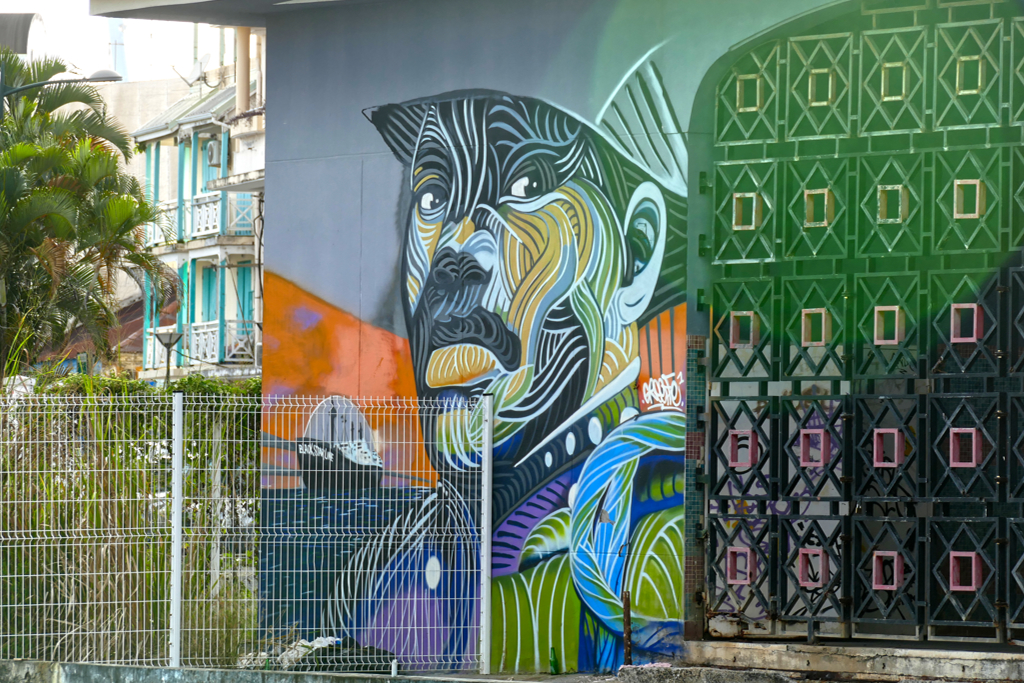
He finds inspiration not only on his home island, but worldwide. As a visual artist, he enjoys being able to communicate with the whole world through universal codes and pictorial languages.
He often portrays personalities who have distinguished themselves in the fight for social justice and resistance against racism.
Today, GREEFFE works as a painter, graphic designer, and graffiti artist. He also founded the streetwear brand GRIFFAW Wear.
Philippe Laurent
Guadeloupean artist Philippe Laurent created the mural as a tribute to the victims of riots that took place in Guadeloupe in May 1967.
“Say Bonjour to the negro!”, ordered Vladimir Snarsky, the owner of a large shoe store in the town of Basse Terre as he released his German shepherd to chase away an old and disabled shoemaker who set up his little stall in front of his store. This act of racist cruelty was the final drop and an ignition spark to a series of protests and strikes across the island in 1967.
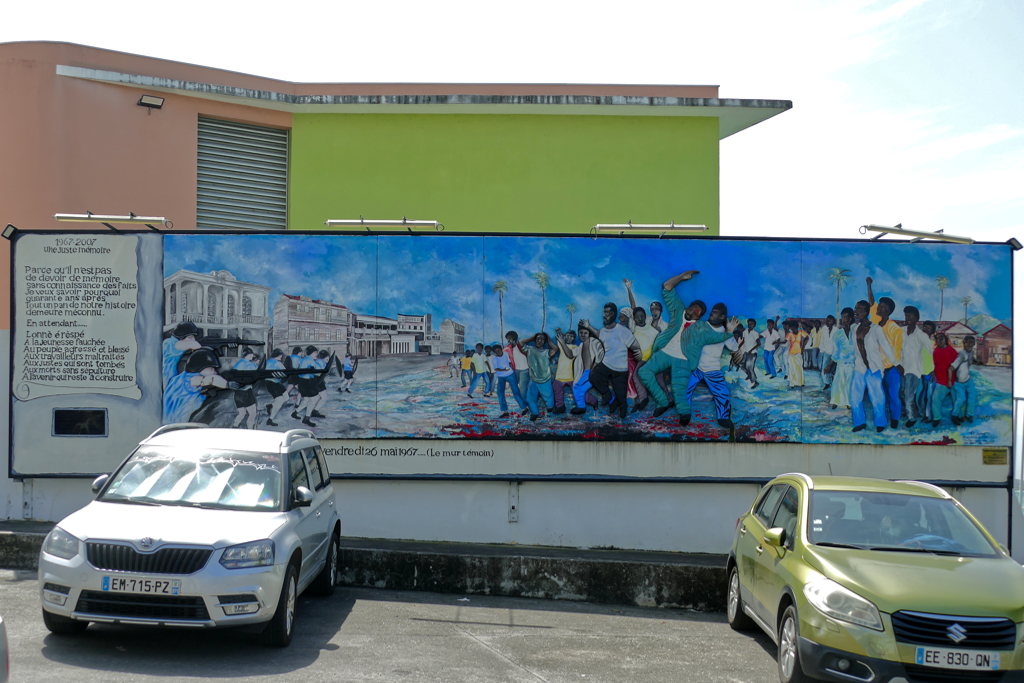
When later negotiations between unions and employer representatives failed, riots began. While demonstrators flung conch shells, stones, and glass bottles, the armed gendarmes threw gas grenades and fired on the protesters. Today, historians can only assume that there were up to 200 deaths as the archives don’t exist anymore.
D. Luidgi
Luidgi was born in Guadeloupe in 1983. At the age of seven he was already drawing his toys and in this way discovered not only the joy of art but also his great talent.

Little by little he developed his very own style according to his personal vision of art. After several exhibitions, illustrations, and an appearance on local television in Guadeloupe, he established himself as an artist. Nevertheless, at the age of 21, and left his home island for Paris. A completely different lifestyle and the discovery of new cultures awaited him there and inspired him to implement them in his large-format paintings.
D. Luidgi creates a mixture of realism and abstract visions.
MACFA
MACFA was born in Paris in 1976. Growing up in the city’s notorious suburbs, he got into the everpresent hip-hop culture. As a young boy, he practiced athletics at an international level. Then he entered the working world, started a family, and finally moved to Guadeloupe in 2003.

In 2011, he entered a professional training course in the field of pedagogy. Included was an art class with Thierry Lima, a visual artist from Guadeloupe. This became MACFA’s creative awakening.
According to his own statement, MACFA discovered a treasure that had been hidden within him all these years.
Art changed his life and he quickly understood the impact of his works on the public. This motivated him to keep going, to provoke thoughts, and to arouse emotions with provocative ideas.
To this date, he paid a visual homage to many personalities from Guadeloupe. Two of his works can also be found at the Centre des Arts et de la Culture. Further works are on the islands of Marie Galante and St. Martin. Next August, he will travel to St. Barthélemy at the invitation of the Island Museum.
Taking into account his immediate environment as well as the news, MACFA makes it a point to give back to the people something that belongs to them in the first place solely through his work
Jimmy Sabas aka MASH
Jimmy Sabas aka MASH was born in Guadeloupe in 1989. He entered the world of graffiti as a teenager. After he completed his studies in fine arts in Martinique in 2012, Sabas has worked as an artist and art teacher in Saint-Martin and Guadeloupe where he is also involved in school and urban collective artistic projects.

Would you have discovered all of this without further explanation? Not me, so I’m glad my guide Loïck explained it to me on my tour with Pousse Pousse**.
MASH has left his amazing traces on the walls of Barcelona, Dakar, Miami, Paris, Stockholm, and his home island Guadeloupe, obviously.
Al Pacman
Al Durand, better known as Al Pacman, was born on the east coast of the neighboring island of Dominica.

He drew a lot at a young age and developed a passion for hip-hop culture and street art. As a self-taught artist, he initially started with tags in the early 1990s. Later he dared to work on large murals.
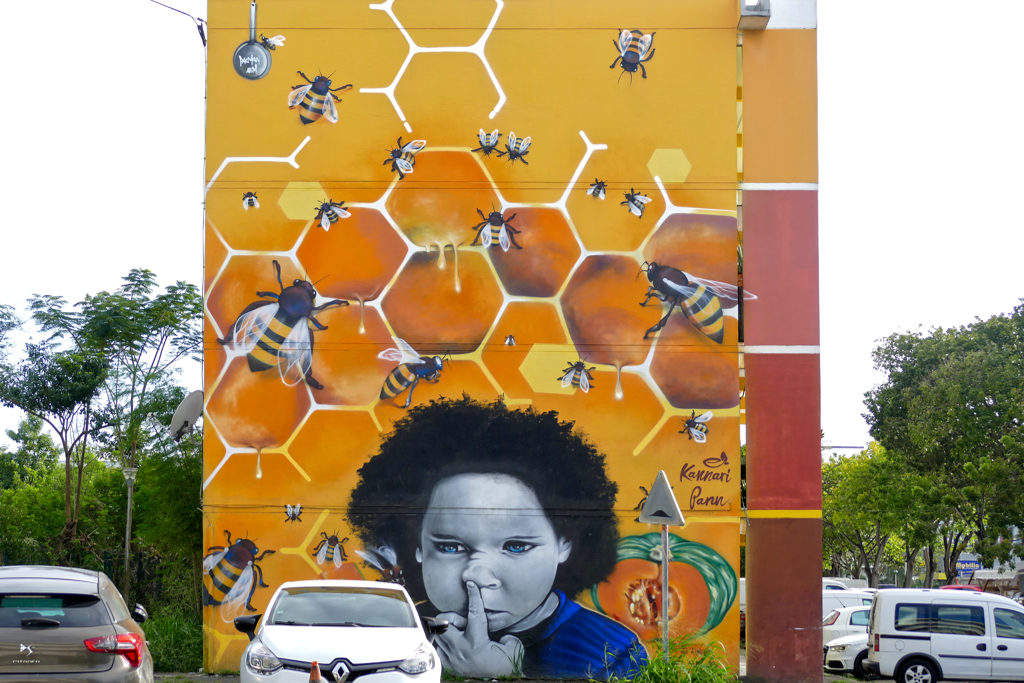
Al Pacman applies his talents across various media and takes on increasingly daring challenges. Over the years he has created work for video clips and television.

In Guadeloupe, Al Pacman has become a household name when it comes to mural painting.
He also took part in exhibitions and festivals in Germany, France, Italy, and Poland.
PWOZ
Some of the best portraits in the center of Pointe-à-Pitre are almost hidden on the walls of a parking garage behind the brutalist town hall. They are from PWOZ, which is pronounced proz. He is a first-generation French urban artist who began painting walls back in the late 1980s.
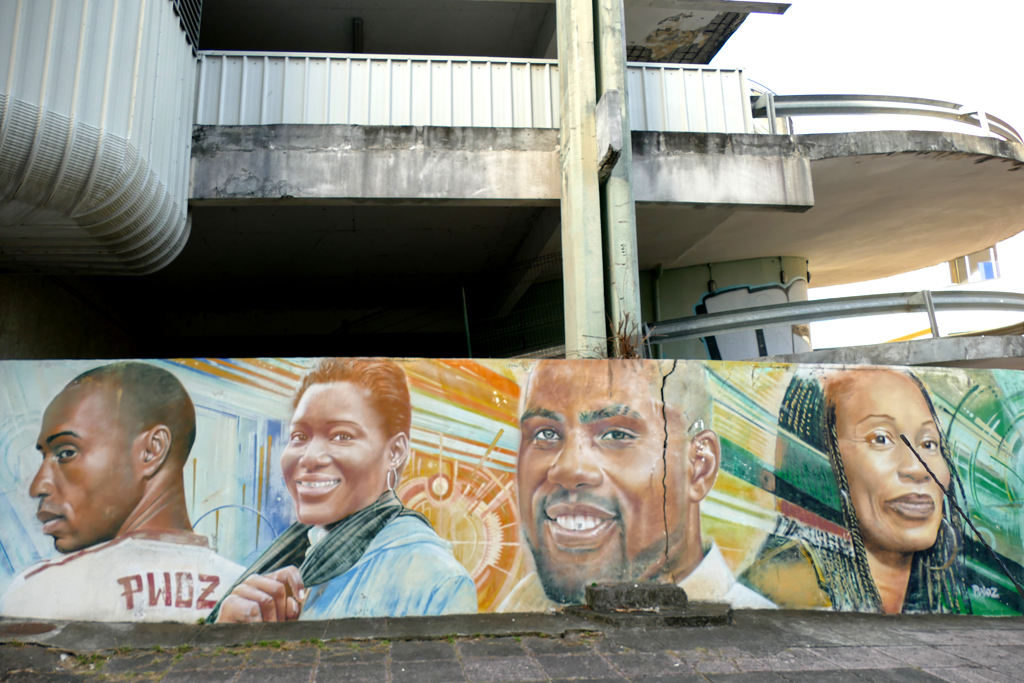
His uncle is none other than Tony Boumba, who supposedly invented the musical movement Zouk. This allowed POWZ to see a realistic future in art. Hence, at the tender age of 16, he left the island for continental France.
For three years, he studied during the day in Paris at the Ecole Boulle, a college of fine arts, decorative and applied arts. In the evenings, he practiced the art of graffiti by making the streets of the French capital his canvas, and the spray can has become his lifelong companion.
At first, he sprayed on trains and subways under time pressure and yet with considerable precision. He later demonstrated his amazing technical skills on large walls in France and other European countries.
In 2002, PWOZ co-founded the 1st Paris International Graffiti Festival, KOSMOPOLITE. Throughout its 11 editions, KOSMOPOLITE hosted no fewer than 700 street artists. Also, there is hardly a well-known urban artist with whom PWOZ has not collaborated.
Jimmy Sheik
Jimmy Sheikboudhou was born in Guadeloupe, where he studied management and accounting. However, when he realized that there had to be more to life, he took his first trip to India at the age of 19. It was the land of his ancestors that inspired him to pick up brushes and spray cans.
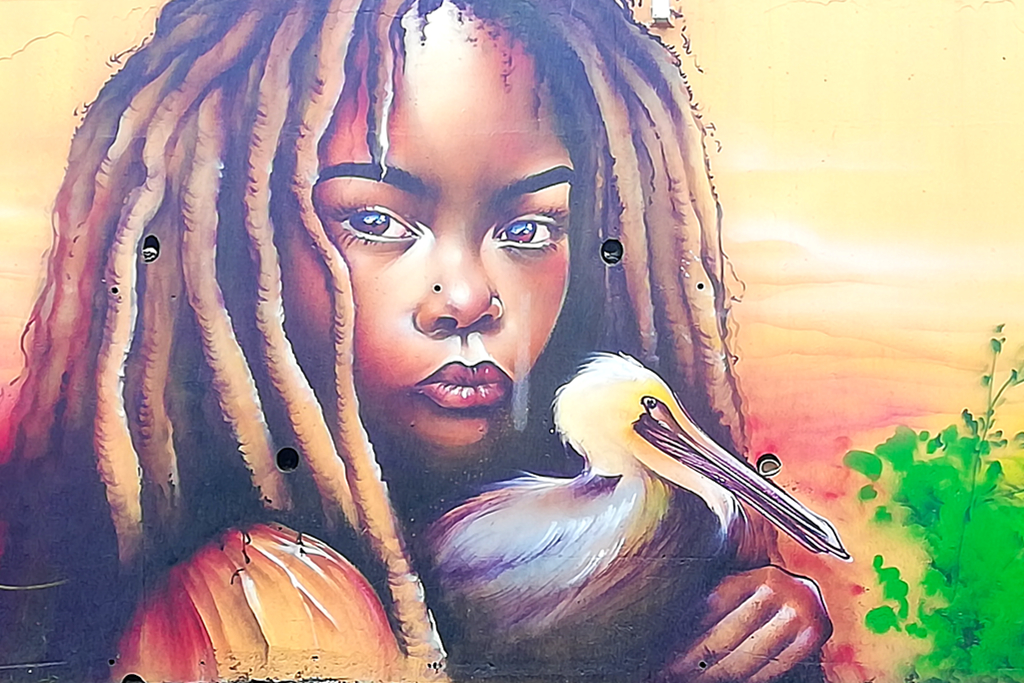
Sheik has been commuting between the two countries, both of which are close to his heart, for more than ten years now. He spends about six months on the Indian subcontinent, where he can express his artistic creativity and his enthusiasm for local customs, traditions, and spiritual and ancestral practices.

His work, omnipresent in Guadeloupe, is influenced by the landscape and symbols of Caribbean culture. Today Sheik’s works can be found on walls on various Caribbean islands but also in Bali, Bangkok, Geneva, Marrakech, Paris, and many cities in India.
Jimmy Sheik’s trademark is a butterfly. He signs all of his works with a monarch as a tribute to his native Guadeloupe, the only island in the world shaped like a butterfly.
SKEM
SKEM was born in 1985 in the French town of Drôme. His father is from Guadeloupe and his mother from Valencia. This is where he discovered the art form of graffiti as an autodidact at the end of the 90s. As I showed in my post Best Street Art in VALENCIA, this city on the southern coast of Spain is a hotspot for urban art to this date.
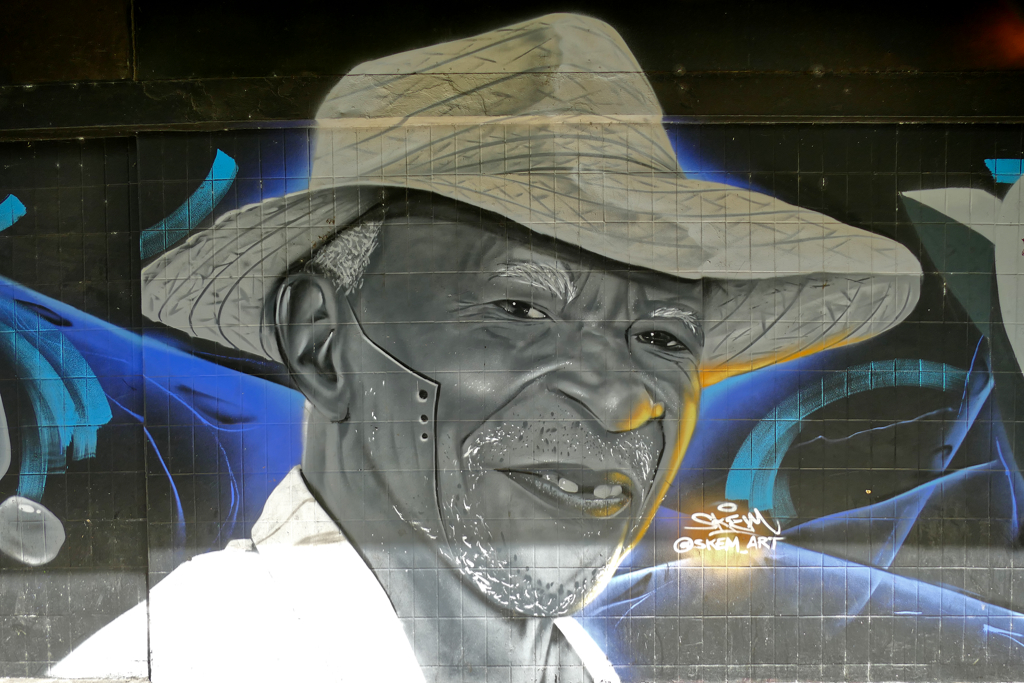
SKEM experimented with urban art and its diverse facets such as lettering, hyperrealistic portraits, or landscapes in the trompe l’oeil style. To perfect his technique, he took a course with Rémi Assezat alias Suspect in 2000.
In 2012, SKEM settled on his father’s home island. As he has been working full-time as an artist since 2017, he expanded his range of techniques to also offer interior and exterior decoration services.
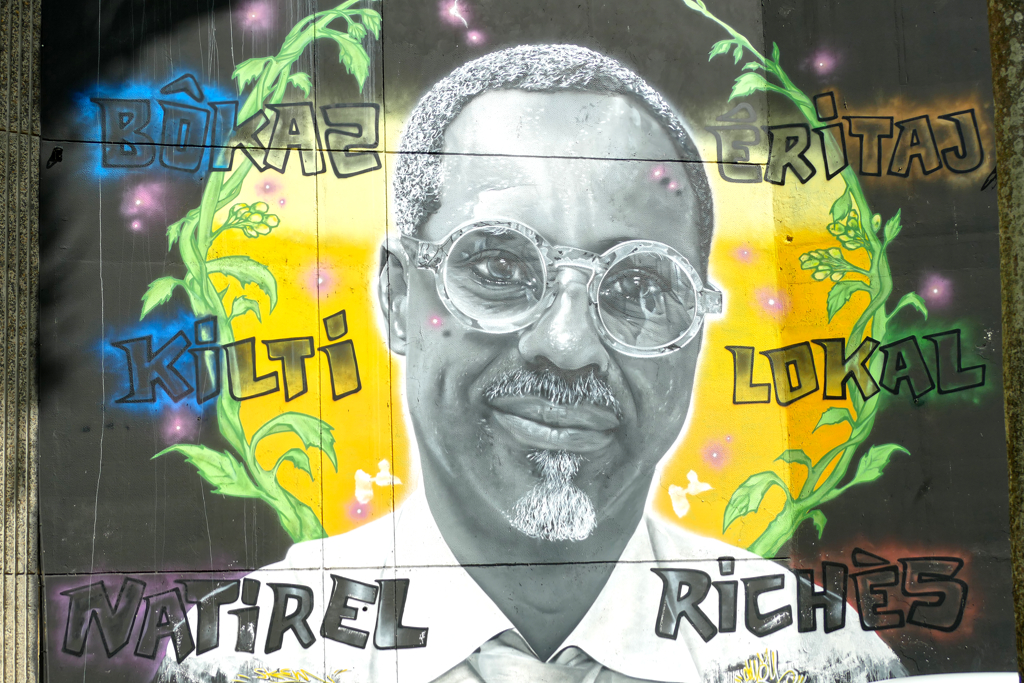
SKEM has participated in the Murs Galeries exhibition at Guadeloupe’s Pôle Caraïbes Airport, as well as numerous regional and international festivals
In 2021 he honored Dr. Henry Joseph with a mural, a passionate defender of local herbal medicine.
Benoit Bottala aka STEEK ONER
Benoit Bottala aka STEEK was born in Guadeloupe in 1983. As a self-taught artist, he came across the already very developed graffiti scene in Guadeloupe at the end of the 1990s. STEEK was able to continually develop and professionalize in the environment of graffiti artists from the local and international scene.
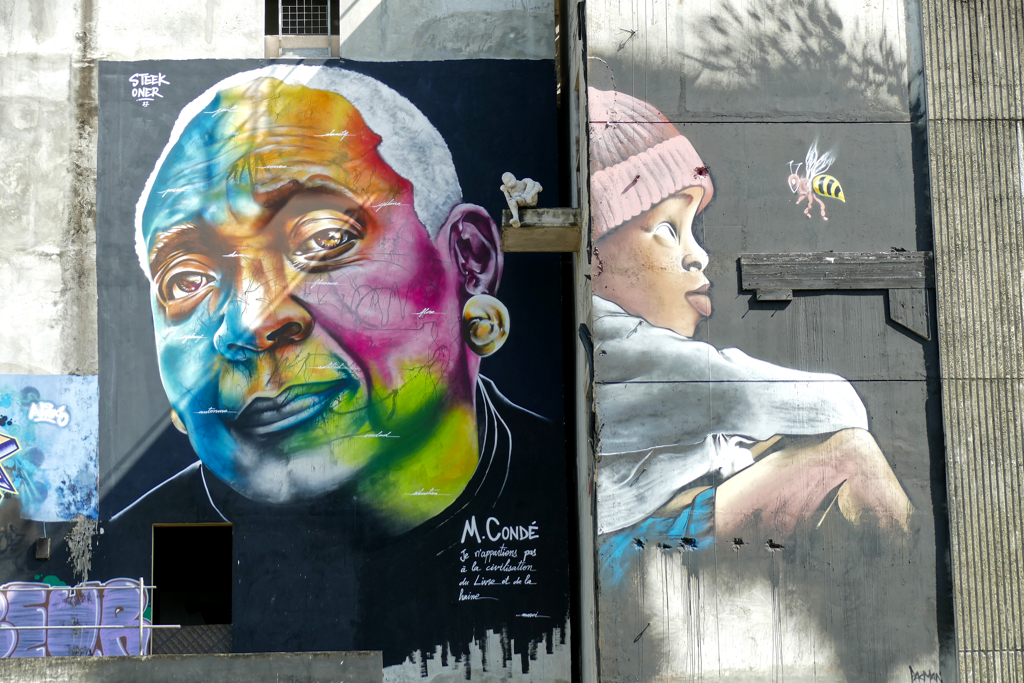
He has been involved in solo and group exhibitions on various Caribbean islands, France, Canada, and the USA.
After discovering the art of body painting in 2010, he became body painting world champion in 2017. He topped that in 2018 with a double world championship. Only one artist before him had achieved this.
Yelow
Yelow was born in Paris in 1979. Inspired by his artist dad and grandfather, he has enjoyed drawing already at a young age. In the 1990s, he began spraying graffiti in the infamous Parisian suburbs and evolved from vandalism to art.
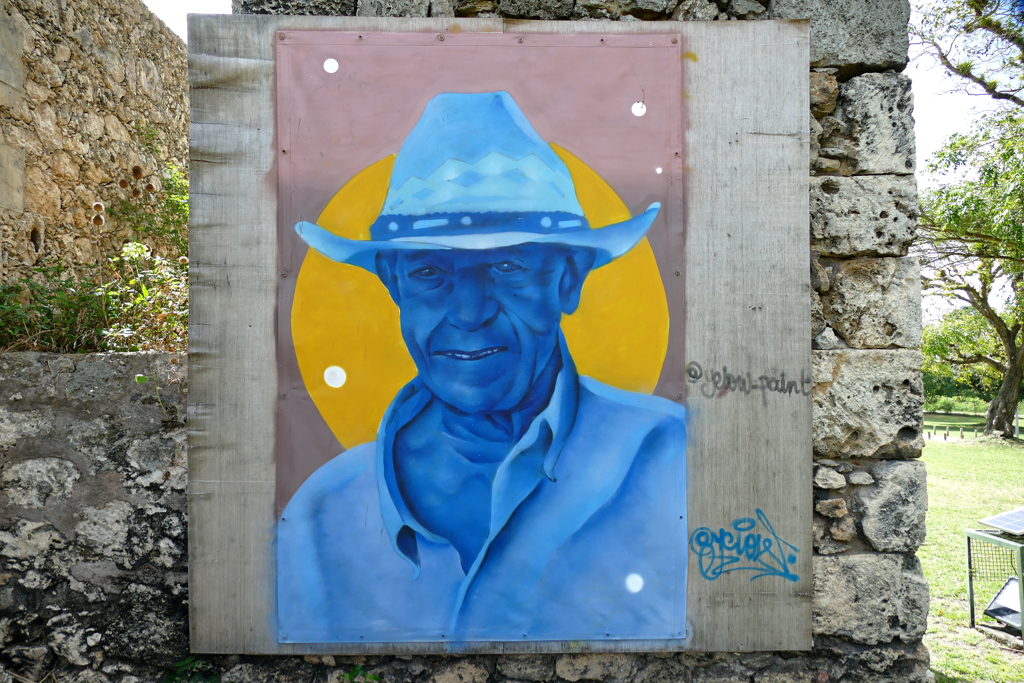
In 2017, Yelow moved to the island of Marie Galante. Although Yelow learned a “real” profession – he is a chef – he is now a professional artist. In his powerful portraits in bold colors, he combines techniques such as painting, spraying, and stenciling. In the process, he transcends the boundaries of established genres and styles. Traces of African and Asian art can be found in his works, but also classic European influences and even pop art. With this artistic mix, Yelow perfectly reflects the Antilles, which are made up of many different cultures.

With each of his works, in which he often composes a trinity of animals, plants, and people, Yelow wants to tell a little story.
Today his murals are on walls mainly in Marie Galante but you can also find them on the butterfly-shaped main islands of Guadeloupe, on Martinique, and Saint Martin.
On Instagram
To dig deeper into the subject and see more of the amazing art the above-featured artists have created, you can just check out their Instagram accounts:
ART’SO
Ronald Cyrille aka B.Bird
Bangastyle
Danae Brissonnet
Yeswoo Dini
Youri Arron aka Dougy
GREEFFE
D. Luidgi
MACFA
Jimmy Sabas aka MASH
Al Pacman
PWOZ
Jimmy Sheik
SKEM
STEEK ONER
Yelow
How to Get Around
In general, the bus network in Guadeloupe is pretty well developed. I can’t think of any place that doesn’t have any bus service at all. At first, things are a bit confusing as there are two different bus companies.
Firstly, the company Karu’lis serves the city and district around Pointe-à-Pitre as well as the southern coast of Grand Terre. Their buses are easily recognizable as they are bright orange. You find lines, maps, schedules, and fares online on their website as well as on the Karu’lis App. There you can also charge money and pay for your tickets as you go. Otherwise, you can buy your ticket just as easily from the driver.
Keep in mind that Karu’lis buses stop their service on Saturdays around noon and that there is no service whatsoever on Sundays.
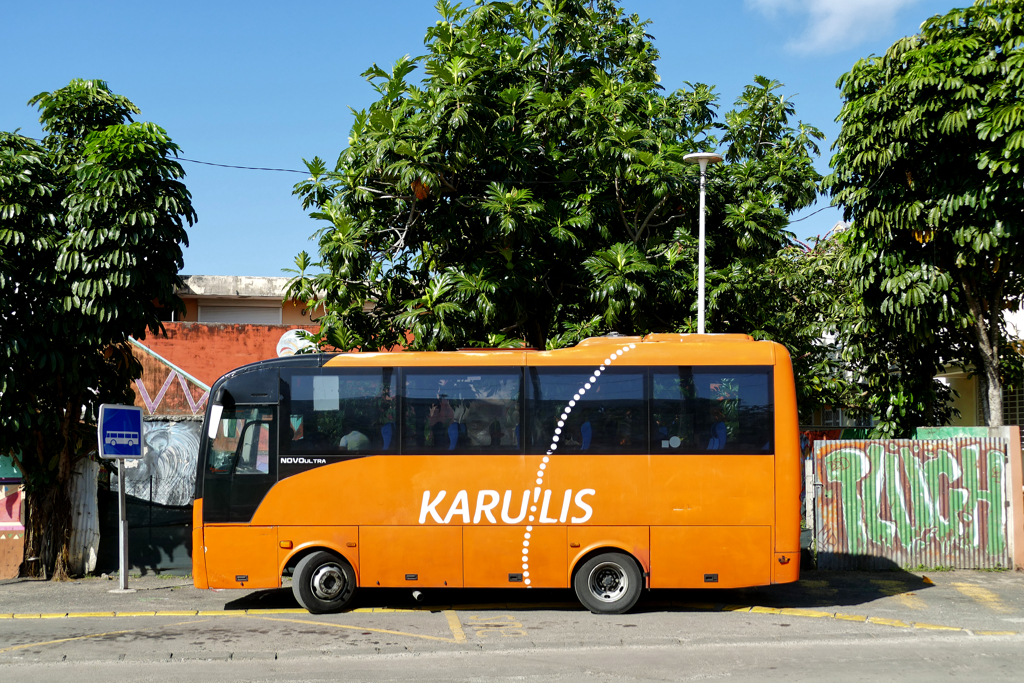
Now, while this sounds really easy and comfortable, I have to inform you that Karu’lis is serving exclusively the above-mentioned part of the island, hence, Pointe-à-Pitre all the way to Pointe des Chateaux.
But what if you want to go to Port Louis or Morne-à-l’Eau?
Well, those are served by a different company. Fortunately, this company also has an excellent website where you find a system map and all timetables as comfortably downloadable PDFs. All you have to do is check on their system map which bus goes where and then look up the times on the respective schedule. Everything is marked in bright colors and sounds probably more complicated than it is.
Do Your Research
While this other bus company is at least as good and reliable as Karu’lis, it has two major flaws: Firstly, there is no App, you have to get all the info from their website. I actually recommend printing out all the schedules before your trip. Don’t worry, there aren’t that many.
The other problem is that they aren’t on Google Maps. So while you can look up the bus from Pointe-à-Pitre to Sainte Anne on Google Maps just like you’d look for a connection in Paris or London, you cannot do that for the other buses. This does not mean they are less reliable, you only have to check all your connections on their website.
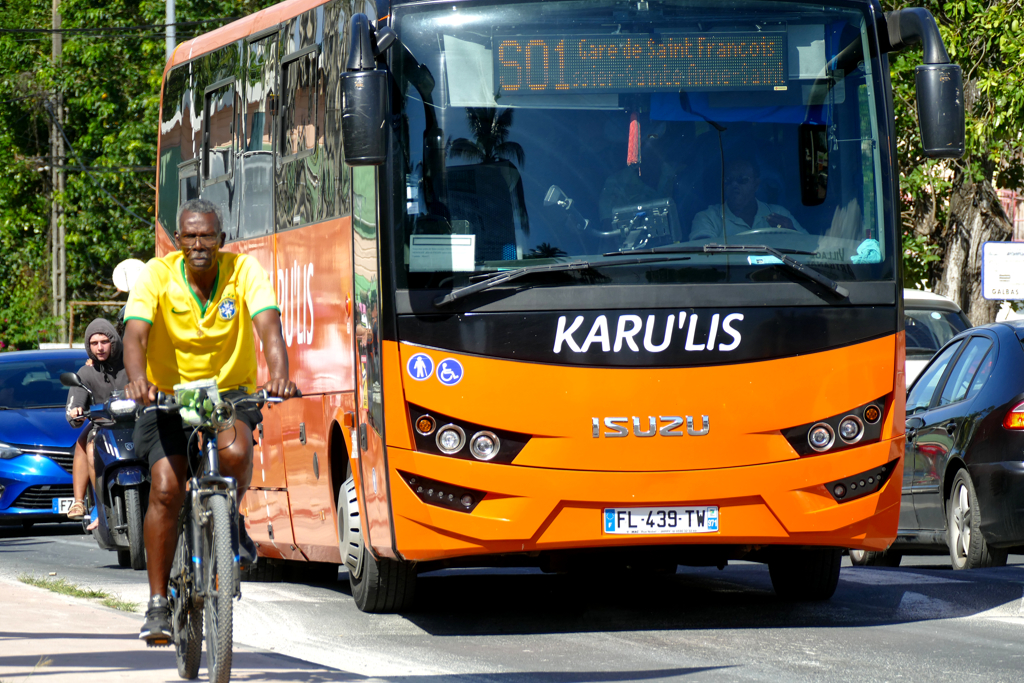
One last but very important thing: To go places that Karu’lis isn’t serving, you basically always have to change buses in Pointe-à-Pitre. There are very few exceptions to this rule. However, it is important to know that Karu’lis’ coaches are going to the Gare De Darboussier east of the port basin while all the other coaches – even those going to the north and the northeast coast of Grand Terre – are leaving from the Gare Routière de Bergevin located close to the cruise terminal. Don’t look for it on Google Maps, they will send you to a roundabout about twenty minutes north of the correct bus terminal. Believe me, been there, done that.
These two bus terminals are about a 20-minute walk from each other, so keep that in mind when planning your trip.
Seven Tips For Exploring Guadeloupe By Public Bus
- The most important tip to make your bus ride more enjoyable: Don’t look at it as a wasted period of time between two meaningful activities. No, think of it as an original tour in an authentic vehicle: Enjoy the amazing scenery, the turquoise waters, the endless sugarcane fields, and the swaying palm trees.
This is neither New York nor Paris nor Tokyo, this is a Caribbean island, and the bus ride is part of the whole experience. - Don’t plan too much for one day. One or two destinations will be enough. Yes, in cities like London or Berlin, you can design a meticulous program for the day and follow through. Taking a day trip on public buses in Guadeloupe is more complex and at times also tiring: you’ll be walking quite a bit and you’ll have to carry all sorts of stuff with you. And all this in the tropical heat. Believe me: Less is definitely more.
- However, plan your trip as thoroughly as possible in advance by checking and downloading the timetables from the Région Guadeloupe’s website as well as Karu’lis’ website and by checking connections on Google Maps or the Karu’lis App wherever possible.
- Be at the stop at least ten, better 20 minutes before the scheduled time as coaches tend to arrive far too early.
- While waiting, don’t get distracted by reading or chatting with others. Keep your eyes on the road if the bus is coming. Because if you just hang around at the bus stop, the driver won’t consider you a potential passenger and might just merrily pass you by. As soon as you see the bus approaching, give the driver a sign by lifting your arm or waving.
- Make sure to have small change to pay your fare as the drivers accept only bills up to 10 €uros.
- Never rely on the last possible connection or the latest scheduled coach. Plan your trip in a way that you can take at least one later bus.
Map
This map should help you to find the murals I’m introducing in this post. Clicking on the slider symbol at the top left or the full-screen icon at the top right will display the whole map including the legend.
Looking for the Best Street Art in Guadeloupe was only one of the awesome things I got to do on my visit to the island. For stories and information on other parts of the island, check out my posts
Best Places to Visit in Grand Terre, the Eastern Wing of GUADELOUPE (also by public bus)
Best Places to Visit in Basse Terre, the Western Wing of GUADELOUPE (also by public bus)
The Best Beaches in Guadeloupe You Can Easily Visit by Public Bus
Guadeloupe: What Not to Miss on a Visit to the Island of Marie Galante
For general information on the island of Guadeloupe, go to the main post
Grand GUADELOUPE: Complete Guide And Perfect Itineraries (also for travels by public bus)
There, you’ll find comprehensive information and tips that will make your trip much smoother and more enjoyable.
Pinnable Pictures
If you choose to pin this post on the Best Street Art in Guadeloupe for later, please use one of these pictures:
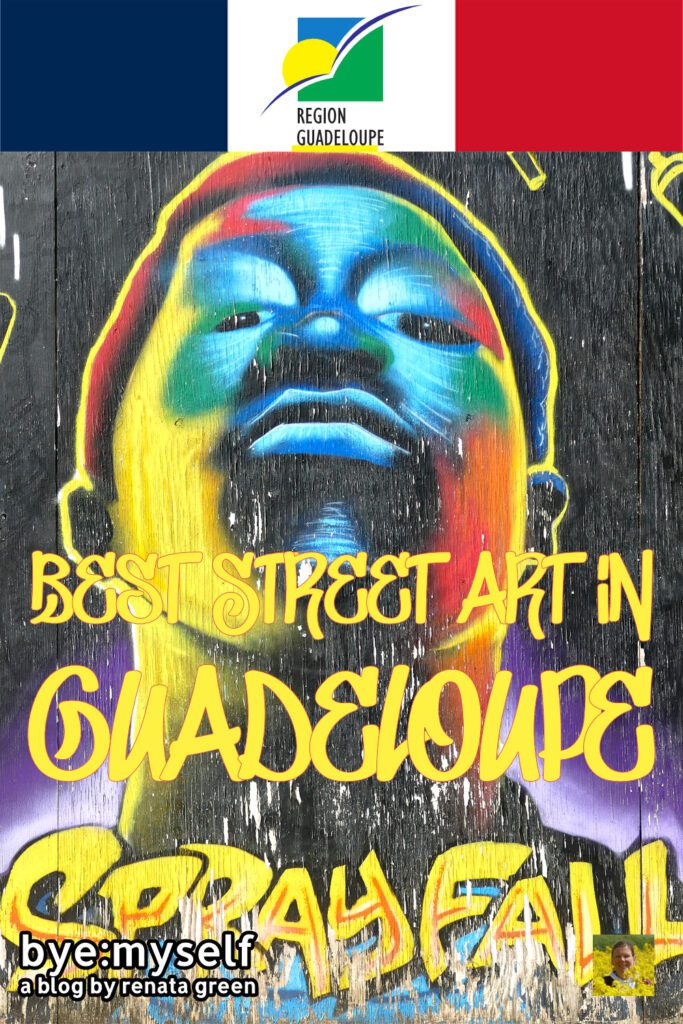
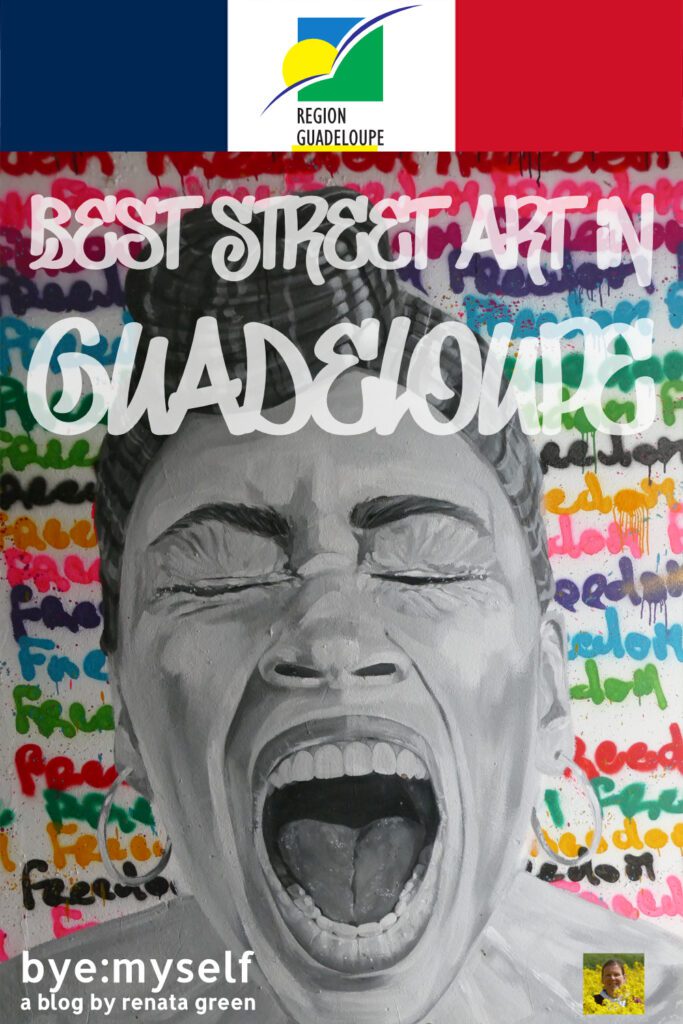
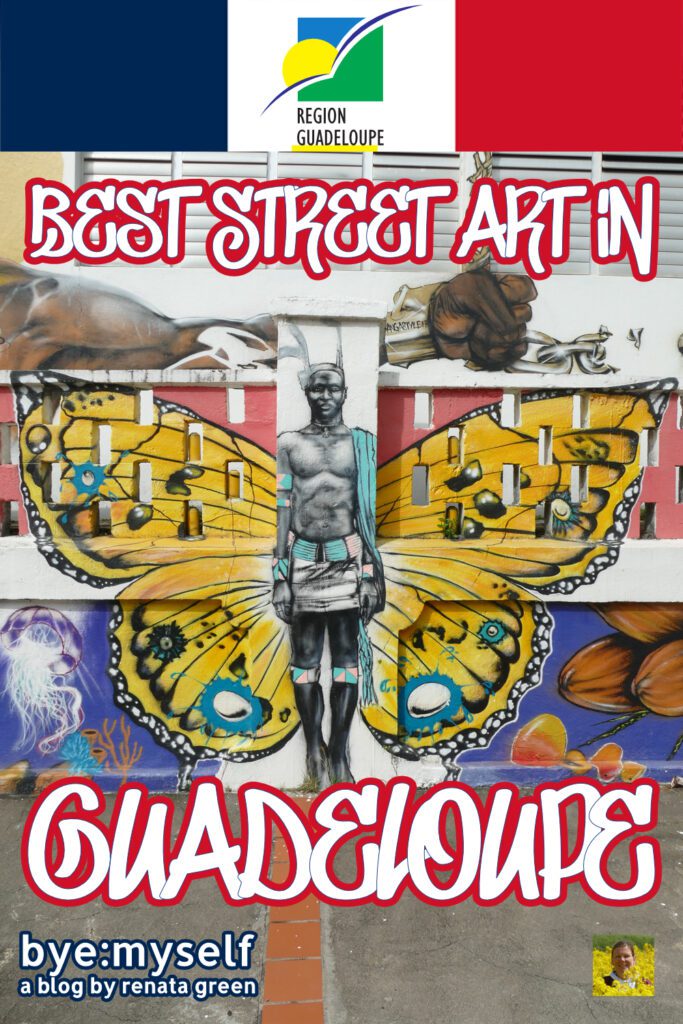
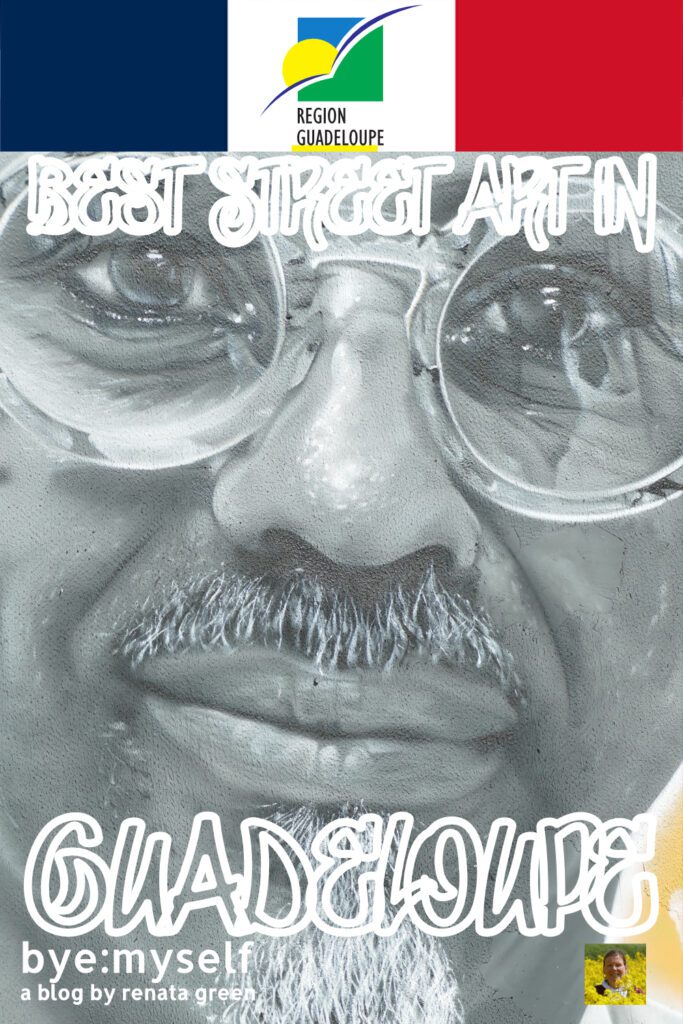
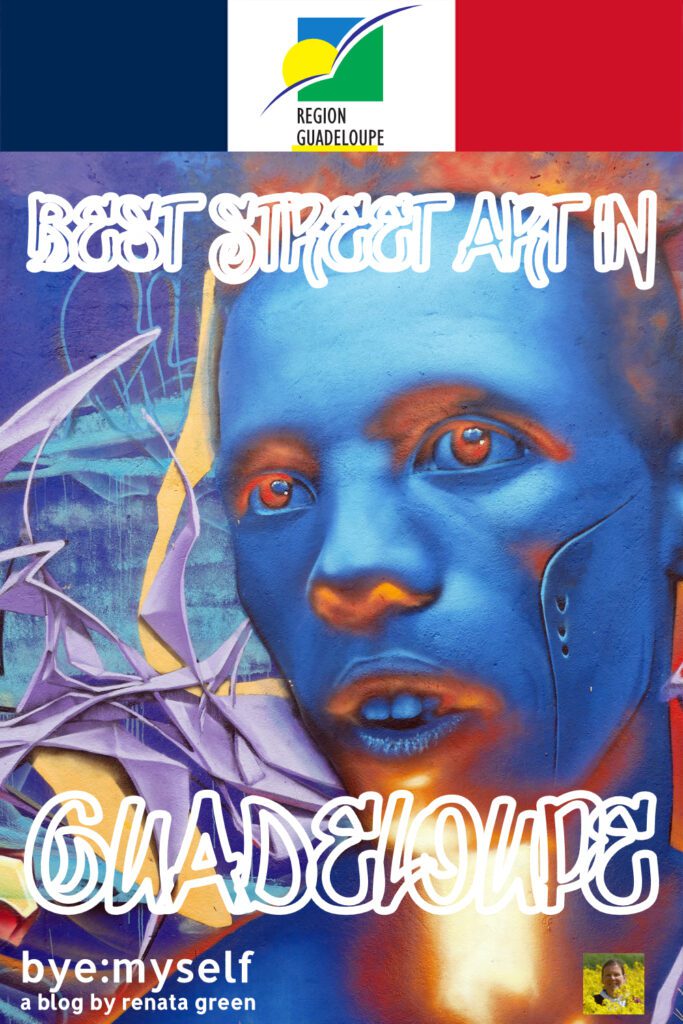

Do You Love Urban Art as much as i do? Then make sure to check out also these posts:
The Best Street Art in MARTINIQUE
Four Days in AMSTERDAM – Unique Things To See on a Long Weekend
Best STREET ART in PALMA de MALLORCA
Best Street Art in LISBON – Part II: Marvila
Best Street Art in PORTO
Best Street Art in PALERMO
MAGNIFICENT MARTINIQUE: Ten Places Not to Miss on Your Visit (even when exploring by public bus)
Street Art in Rio de Janeiro: The Voice of Colors by Rita, Eduardo, and Jorge
* This is an affiliate link. If you book through this page, not only do you get the best deal. I also get a small commission that helps me run this blog. Thank you so much for supporting me!
** Pousse Pousse – Ti Balad Peyi was kind enough to let me join one of their tours for free. Nevertheless, all opinions on their services are mine and were by no means influenced by the company.

